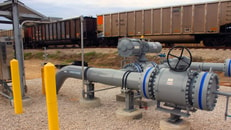Setting a new standard In flammable gas detection
Pellistor-based sensors all use a heated catalyst to combust flammable gas. The consequent temperature change can then be directly related to the gas concentration. Any such device based on catalysts will be susceptible to ‘poisoning’.
Poisoning occurs where certain chemicals and compounds react with the surface of the catalyst and by their action, reduce the response of the catalyst to the desired target gas. These chemicals and compounds fall into two groups: poisoning agents act on the catalysts irreversibly; inhibitors are recoverable to some degree. Typical poisoning agents would be organic silicon compounds.
A poorly designed catalyst structure can lose over 90% of its response in a few minutes when exposed to a standard 10 ppm (parts-per-million) poisoning agent (HMDSO) used in testing. Typical inhibitors where the poisoning effect is reversible could be halogen containing hydrocarbons or compounds containing sulfur.
... to continue reading you must be subscribed























